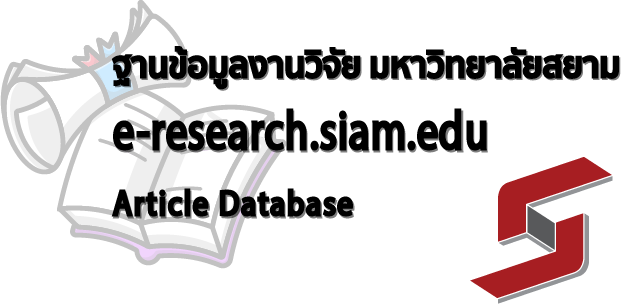- KB Home
- หลักสูตรปริญญาตรี|Bachelor Degree
- คณะพยาบาลศาสตร์
- ความคาดหวังและการรับรู้ของผู้รับบริการต่อพฤติกรรมจริยธรรมในการปฏิบัติการพยาบาลของพยาบาลอนามัยชุมชน ในหน่วยบริการปฐมภูมิ
- 1. การอ้างอิง/citation
- 2. บทคัดย่อ
- 3. ABSTRACT
- 4. Link to Publication
- 5. Link to PDF
- 6. ความคาดหวังและการรับรู้ของผู้รับบริการต่อพฤติกรรมจริยธรรมในการปฏิบัติการพยาบาลของพยาบาลอนามัยชุมชน ในหน่วยบริการปฐมภูมิ | Clients’ Expectation and Perception towards Ethical Behaviour in Nursing Practice of Community Health Nurse in Primary Care Unit
- 7. Related
| ชื่อบทความ: | ความคาดหวังและการรับรู้ของผู้รับบริการต่อพฤติกรรมจริยธรรมในการปฏิบัติการพยาบาลของพยาบาลอนามัยชุมชน ในหน่วยบริการปฐมภูมิ |
| Research Article: | Clients’ Expectation and Perception towards Ethical Behaviour in Nursing Practice of Community Health Nurse in Primary Care Unit |
| ผู้เขียน/Author: | วิภานันท์ ม่วงสกุล และ ชนิดา มัททวางกูร | Wipanun Muangsakul, Chanida Mattavangkul |
| Email: | wipanun.mua@siam.edu |
| สาขาวิชา/คณะ: | คณะพยาบาลศาสตร์ มหาวิทยาลัยสยาม กรุงเทพฯ 10160 |
| Department/Faculty | Faculty of Nursing, Siam University, Bangkok 10160 |
| Published/แหล่งเผยแพร่ | วารสารแพทย์นาวี ปีที่ 47 ฉบับที่ 3 (กันยายน-ธันวาคม) พ.ศ. 2563 | Royal Thai Navy Medical Journal Volume 47 No.3 September-Dember 2020 |
การอ้างอิง/citation
วิภานันท์ ม่วงสกุล และ ชนิดา มัททวางกูร. (2563). ความคาดหวังและการรับรู้ของผู้รับบริการต่อพฤติกรรมจริยธรรมในการปฏิบัติการพยาบาลของพยาบาลอนามัยชุมชน ในหน่วยบริการปฐมภูมิ. วารสารแพทย์นาวี, 47(3), 576-593.
บทคัดย่อ
การศึกษานี้เป็นการวิจัยเชิงบรรยาย (Descriptive research) เพื่อศึกษาระดับความคาดหวัง ระดับการรับรู้ และความแตกต่างระหว่างระดับความคาดหวังกับระดับการรับรู้ของผู้รับบริการต่อพฤติกรรมจริยธรรมในการปฏิบัติการพยาบาลของพยาบาลอนามัยชุมชนในหน่วยบริการปฐมภูมิ เก็บข้อมูลโดยใช้แบบสอบถาม พื้นที่ศึกษาทำการสุ่มแบบหลายขั้นตอน (Multi-stage random sampling) ได้แก่ นนทบุรี สมุทรสาคร และนครปฐม กลุ่มตัวอย่างใช้วิธีการเลือกแบบเจาะจง (Purposive sampling) ตามเกณฑ์ที่กำหนด จำนวน 444 คน วิเคราะห์ข้อมูลโดยความถี่ ร้อยละ ค่าเฉลี่ย ส่วนเบี่ยงเบนมาตรฐาน และสถิติทดสอบทีแบบจับคู่ (Paired t-test)
ผลการศึกษา พบว่า ผู้รับบริการมีระดับความคาดหวังถึงพฤติกรรมจริยธรรมในการปฏิบัติการพยาบาลอยู่ในระดับมาก (X̅ = 4.11, SD = 0.74) เมื่อจำแนกรายด้าน พบว่า คะแนนเฉลี่ยสูงสุด คือ ด้านการไม่ทำอันตราย (X̅ = 4.27, SD = 0.81) สำหรับพฤติกรรมจริยธรรมที่ผู้รับบริการความคาดหวังที่มีคะแนนเฉลี่ยสูงสุด คือ การได้รับซักถามถึงประวัติการแพ้ยาหรือสารอื่นใดก่อนรับยา (X̅ = 4.30, SD = 0.88) รองลงมา คือ ได้รับการตรวจสอบชื่อ นามสกุล ทุกครั้งก่อนรับยา (X̅ = 4.29, SD = 0.87) และความคาดหวังที่มีคะแนนเฉลี่ยน้อยที่สุด คือ การมีส่วนร่วมในการวางแผนการรักษาพยาบาลของตนเอง (X̅ = 3.78, SD = 0.98) ในด้านการรับรู้ พบว่า ผู้รับบริการมีระดับการรับรู้ถึงพฤติกรรมจริยธรรมในการปฏิบัติการพยาบาลอยู่ในระดับมากที่สุด (X̅ = 4.26, SD = 0.63) เมื่อจำแนกรายด้าน พบว่า ด้านการไม่ทำอันตรายมีคะแนนเฉลี่ยสูงที่สุดเช่นกัน (X̅ = 4.42, SD = 0.69) และพฤติกรรมจริยธรรมที่ผู้รับบริการรับรู้มีคะแนนเฉลี่ยสูงสุด คือ การได้รับการตรวจสอบชื่อ นามสกุลทุกครั้งก่อนรับยาค่าเฉลี่ย (X̅ = 4.45, SD = 0.75) รองลงมา คือ ได้รับการซักถามถึงประวัติการแพ้ยาหรือสารอื่นใดก่อนรับยา (X̅ = 4.44, SD = 0.77) และการรับรู้ที่มีคะแนนเฉลี่ยน้อยที่สุด คือ การมีส่วนร่วมในการวางแผนการรักษาพยาบาลของตนเอง (X̅ = 3.91, SD = 0.92) ซึ่งเป็นการแสดงถึงการเคารพเอกสิทธิ์ของผู้รับบริการ โดยค่าเฉลี่ยระดับการรับรู้ต่อพฤติกรรมจริยธรรมสูงกว่าระดับความคาดหวัง อย่างมีนัยสำคัญทางสถิติที่ระดับ .001 และค่าความแตกต่างในภาพรวม (P-E = 0.15) โดยช่องว่างของความแตกต่างระหว่างความคาดหวังกับการรับรู้ พบว่า พฤติกรรมจริยธรรมด้านการเคารพเอกสิทธิ์มีความแตกต่างกันน้อยที่สุด (0.12) รองลงมา คือ ด้านการทำประโยชน์ (0.13) และด้านความยุติธรรม (0.17) ที่มีความแตกต่างของระดับความคาดหวังกับการรับรู้มากที่สุด
ข้อเสนอแนะ พยาบาลอนามัยชุมชนพึงปฏิบัติการพยาบาลที่ไม่ทำอันตรายแก่ผู้รับบริการ ซึ่งเป็นสิ่งที่ผู้รับบริการต้องการมากที่สุด และควรพัฒนาด้านการเคารพเอกสิทธิ์ในการปฏิบัติงานให้มากยิ่งขึ้น เพื่อให้ผู้รับบริการได้รับข้อมูลเกี่ยวกับการรักษาพยาบาล ซึ่งเป็นการตระหนักถึงความเป็นบุคคลของผู้ป่วย และสิทธิของผู้ป่วยด้วย
คําสําคัญ: ความคาดหวัง, การรับรู้, พฤติกรรมจริยธรรม, พยาบาลอนามัยชุมชน
ABSTRACT
The descriptive research aimed to study the level of expectations, perceptions and the difference between the level of expectations and perceptions of clients regarding ethical behaviour in nursing practice of community health nurses in Primary Care Unit. The data were collected by using questionnaires. The multi-stage random sampling was used for study area selection including Nonthaburi, Samut Sakhon, and Nakhon Pathom. 444 sample were selected by purposive sampling according to inclusion criteria. Descriptive statistics (i.e. frequencies, percentage, mean, and standard deviation) and inferential statistics (i.e. Paired t-test) were used for analyzing the data.
The result revealed that the clients had a good level of expectations (X̅ = 4.11, SD = 0.74). For each subscale, it was found that the highest mean score was non-maleficence (X̅ = 4.27, SD = 0.81). For ethical behaviour expected by clients, the highest mean score asked about any drug or other drug allergy history before receiving any medication (X̅ = 4.30, SD = 0.88), checked your name-surname every time before receiving the medicine (X̅ = 4.29, SD = 0.87) and the lowest mean score was their own participation in medical planning (X̅ = 3.78, SD = 0.98). The perception of the clients were very high (X̅ = 4.26, SD = 0.63). For each subscale, it was found that the highest mean score was non-maleficence as well (X̅ = 4.42, SD = 0.69) and ethical behaviour perceived by clients with the highest mean score was checked name-surname every time before receiving the medicine (X̅ = 4.45, SD = 0.75), asked about any drug or other drug allergy history before receiving any medication (X̅ = 4.44, SD = 0.77) and the lowest mean score was their own participation in medical planning (X̅ = 4.26, SD = 0.63). It showed respect for autonomy of the clients. The mean score of perceptions of ethical behaviour was higher than expectations and the score with less perceptions was their own participation in medical planning (X̅ = 3.91, SD = 0.92). Statistical significance at the level of 0.001 including the difference between expectations and perceptions in all aspects (P-E = 0.15). The gap of difference between the level of expectations and perceptions showed ethical behaviour in respect for autonomy was the least different (0.12). The second was beneficence (0.13) and justice (0.17) had the greatest difference between expectations and perceptions.
Recommendations, community health nurses should perform nursing activities that apply non-maleficence, which is needed by the most clients and should develop the respect for autonomy, so that clients can receive information about medical care, concerning about the patient’s individuality and the rights of patients as well.
Keywords: expectation, perception, ethical behaviour, community health nurse.
ความคาดหวังและการรับรู้ของผู้รับบริการต่อพฤติกรรมจริยธรรมในการปฏิบัติการพยาบาลของพยาบาลอนามัยชุมชน ในหน่วยบริการปฐมภูมิ | Clients’ Expectation and Perception towards Ethical Behaviour in Nursing Practice of Community Health Nurse in Primary Care Unit
Faculty of Pharmacy, Siam University, Bangkok, Thailand
Related
- บทบาทของเภสัชกรในการประเมินการใช้ยาผู้ป่วยภาวะหัวใจล้มเหลว
- การป้องกันลิ่มเลือดอุดตันในผู้ป่วยมะเร็งเม็ดโลหิตขาวชนิดมัยอีโลมาที่ได้รับยาปรับภูมิคุ้มกัน
- การศึกษาปัญหาเกี่ยวกับการใช้ยาในเด็กและวัยรุ่นที่มีภาวะทางสุขภาพจิต
- ปัจจัยของผู้ป่วยที่มีผลต่อความร่วมมือในการใช้ยางานบริบาลทางเภสัชกรรม โรงพยาบาลบางปลาม้า สุพรรณบุรี
- การพัฒนาองค์ประกอบและพฤติกรรมบ่งชี้ของทักษะการสื่อสารทางเภสัชกรรมสำหรับนิสิต/นักศึกษาเภสัชศาสตร์
- การศึกษาขนาดยาต้านจุลชีพที่ใช้บ่อยในหอผู้ป่วยวิกฤต โดยวิธี Monte Carlo simulation ในผู้ป่วยภาวะไตวายเฉียบพลันที่ได้รับการรักษาด้วยการบำบัดทดแทนไตแบบต่อเนื่อง
- แนวทางการรักษาภาวะย่อยอาหารผิดปกติไร้เหตุทางกายสำหรับเภสัชกรชุมชน
- การวิเคราะห์ความถูกต้องของคำสั่งใช้ยา:การปรับขนาดยา


